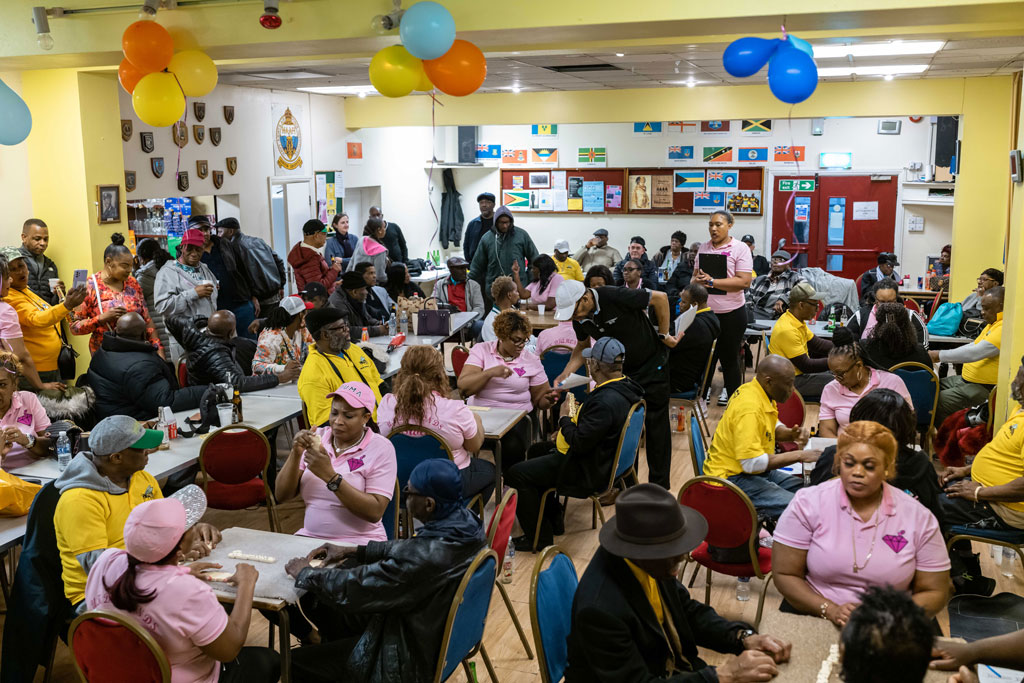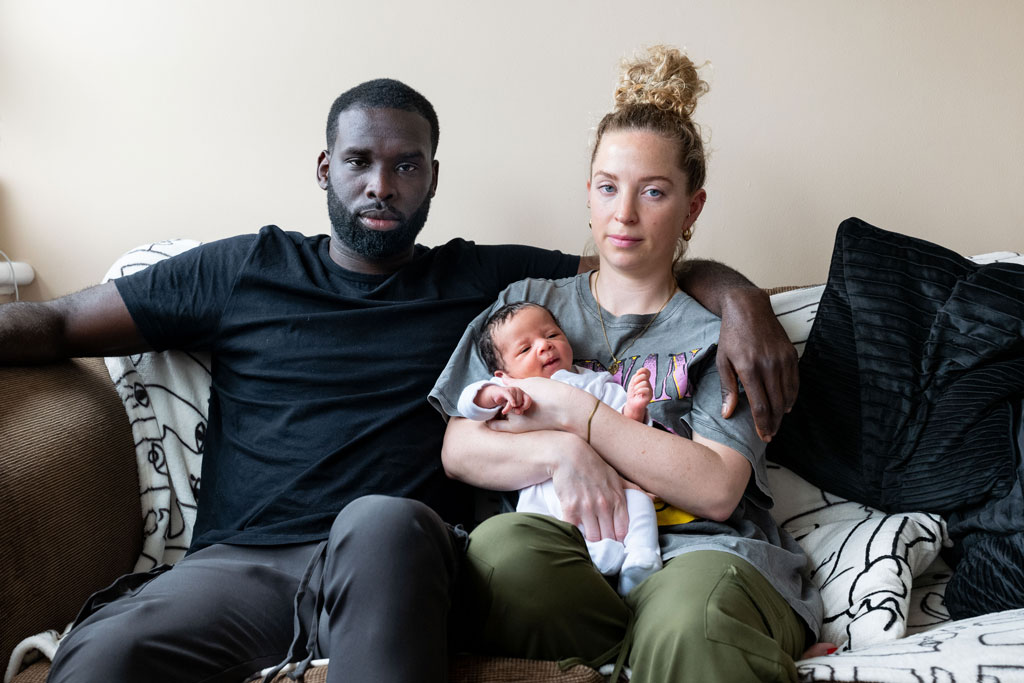Peter Dench speaks to Jim Grover about his moving photo-reportage exploring how the generations that followed the original Windrush generation are living their lives in the UK today.
After nearly a month at sea, on 12 June 1948, the British troopship HMT Empire Windrush anchored on a misty River Thames at Tilbury Docks, Essex. On board were 1,027 passengers and two stowaways.
More than 800 of those passengers gave their last place of residence as being the Caribbean. Many were anxious, believing a command would come for the ship to turn back. As they disembarked the following day, the mood was celebratory. Among those hoping for a new life in the United Kingdom was a future Mayor of Southwark, Sam King, who had served with the wartime RAF. His family had reportedly sold three cows to buy his ticket, which cost £28 10s, upwards of $700 / £600 today.
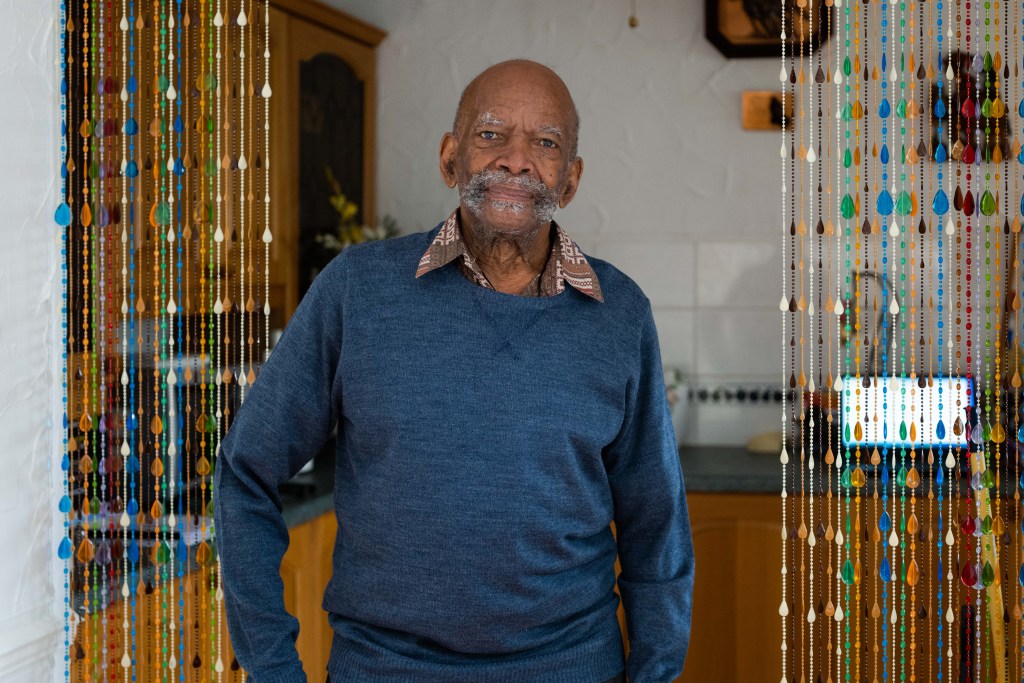
97-year-old Alford Gardner who was born in Jamaica and who is one of only two known surviving adult passengers from MV Empire Windrush in 1948. Photo credit: Jim Grover.
Another passenger looking to build a life thousands of miles from home was Alford Gardner. Born in Jamaica in 1926, Gardner is one of only two known adult passengers alive today who travelled on the Windrush. He served as an engineer and motor mechanic during World War II before he demobbed and sailed back to Jamaica.
Finding it difficult to settle, he felt his future was in the UK. Borrowing money from his father, he bought a ticket to travel with his older brother on the Windrush. Gardner finally settled in Leeds. Seventy years later, at the last count, he had 21 great- grandchildren and no regrets about his decision to move to the UK.
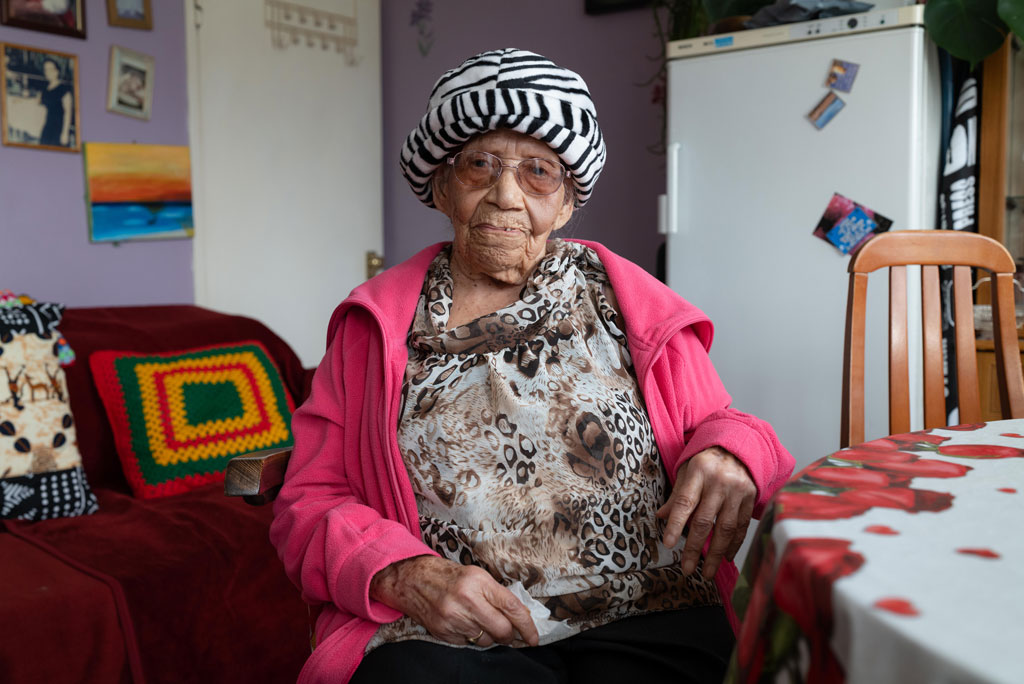
Merah-Louise Smith was born in Jamaica on 9 November 1912. Aged 110, she is amongst the oldest women of Caribbean heritage alive in the UK today. Photo credit: Jim Grover.
Photographer Jim Grover first met Gardner when he photographed and interviewed him for his 2018 reportage Windrush: Portrait of a Generation, which portrays the lives and traditions of the first generation of Caribbean migrants. We are reintroduced to Gardner in Windrush: A Voyage Through the Generations, a new photography exhibition and book by Grover to mark the 75th anniversary of Windrush’s arrival.
The challenge for Grover was to deliver something new. ‘I didn’t want to just go back and focus on the first generation. All their stories are very moving and inspiring but I feel I’ve been there. So I decided to really focus on the generations that have come afterwards and to explore, in particular, how much of the distinctive culture and tradition that the first generation brought, is still living and breathing in the subsequent four generations. That was my first interest,’ he explains.

Led by a young drummer and comprising representatives from a variety of Caribbean and African countries, a parade marches along Brixton Road. Photo credit: Jim Grover.
Fundraising
Grover meticulously delves into the communities and lives of subsequent generations around the area in south London where he has lived for over 30 years and where many from the original Windrush generation settled. The information he gathered is immense as the stories kept on coming. He calculated around $20,000 / £16,000 would be needed to tell them.
Using the Kickstarter crowdfunding platform, $17,000 / £13,401 was pledged of a $12,000 / £10,000 goal (Grover covered the remainder personally). Working closely with photography curator Katy Barron, an exhibition launched on 1 June at the Clapham Library. The exhibition has an overall narrative broken down into nine stories introduced by a text panel limited to 350 words and 12 portraits. The exhibition and book provide a resource for people to delve deeper if desired.
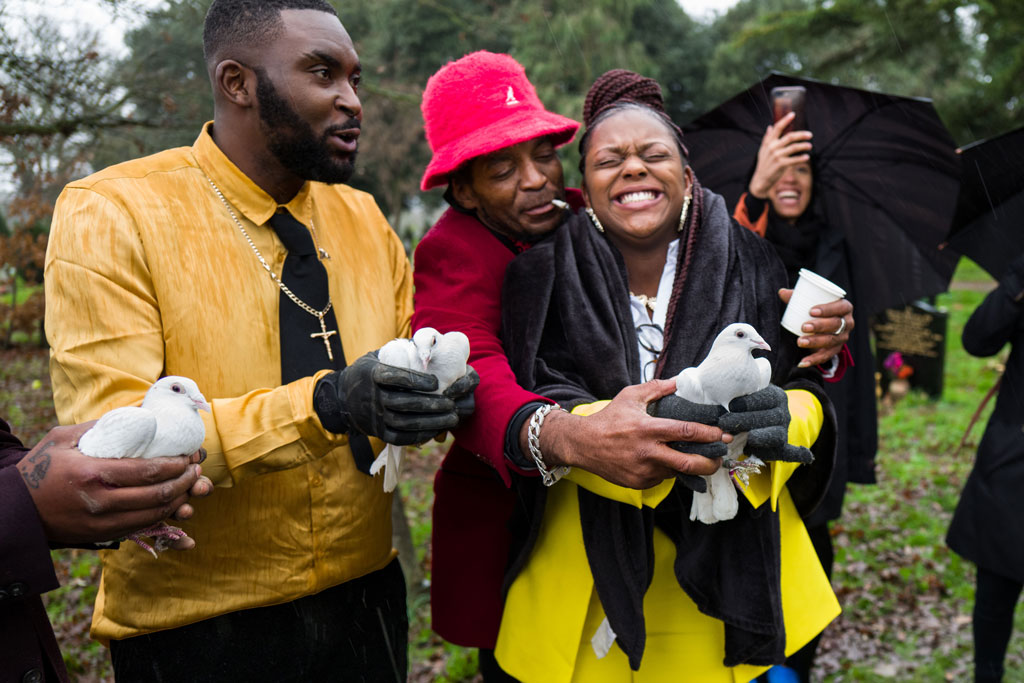
Jayanne and Jordan Davis, third-generation siblings, release white doves at a traditional Jamaican burial of their mother in Lambeth. Photo credit: Jim Grover.
Grover’s reportage invites questions and conversations around heritage and culture, and the passing down of distinctive traditions from one generation to another. Many of the stories centre on the work the women do to keep Caribbean culture alive. Using natural light and working swiftly and without fuss, he took his Leica SL2 and Leica Q (the former with 28mm and 35mm lenses) into community centres, libraries, churches, homes, kitchens and even cemeteries.
In one image packed with emotion, third-generation siblings Jayanne and Jordan Davis release white doves (symbolising the transportation of the soul of the departed to heaven) at a traditional Jamaican burial of their mother in Lambeth Cemetery. In another, singer Audrey Scott belts out her hit song Goodbye My Love to a gyrating crowd at the launch of the Lovers Rock exhibition, a genre of reggae introduced by the second generation, at the Windrush Generation Legacy Association in the Whitgift Centre, Croydon.
‘Contrary to the ordinariness that we typically attach to our own lives, Grover’s pictures expertly deliver the atmosphere from concentration to jubilation as the Diamonds take on a traditionally male pastime and make it their own. Their nicknames emblazoned across their baby pink polo shirts including 43-year-old Nadine (‘Sexy Deen’) Lovelace and the club Captain, Alicia (‘Queen Bee’) Grizzle, 39, the driving forces behind the Diamonds.
As Windrush: A Voyage through the Generations developed, Grover realised he needed to amplify the voices of children of Caribbean heritage. He invited those aged 16 and under to photograph with a mobile phone a family treasure, an artefact that connected them with their heritage; and to deliver a few words about why they had chosen it.

The results exceeded expectations and often tear at the heart: ‘This is a photo of my grandmother. The cloth is her nightdress. I wear it to bed sometimes because she wore it to bed in the hospital in St Vincent, where she died, and she wanted me to have it. It’s passed down the generations. It’s precious because it’s the only thing I have left. I will give this to my oldest child.’ Kencia, aged 10.
‘This is my grandma’s passport which she used when she came to Britain in 1955 when she was 19. It’s on a doily which contained biscuits on her voyage from Jamaica.’ Dexter, aged 11.
‘This dutch pot was given to my grandma, by her mother, when she left Jamaica to come to England in 1960. She carried it in her suitcase.’ Shakeira, aged 16.
Grover’s plan was to curate a giant collage with 75 of the images. He expects that number to be well breached. ‘I’m not going to turn anyone down – that’s madness,’ he says with a smile.
Capturing Windrush future generations
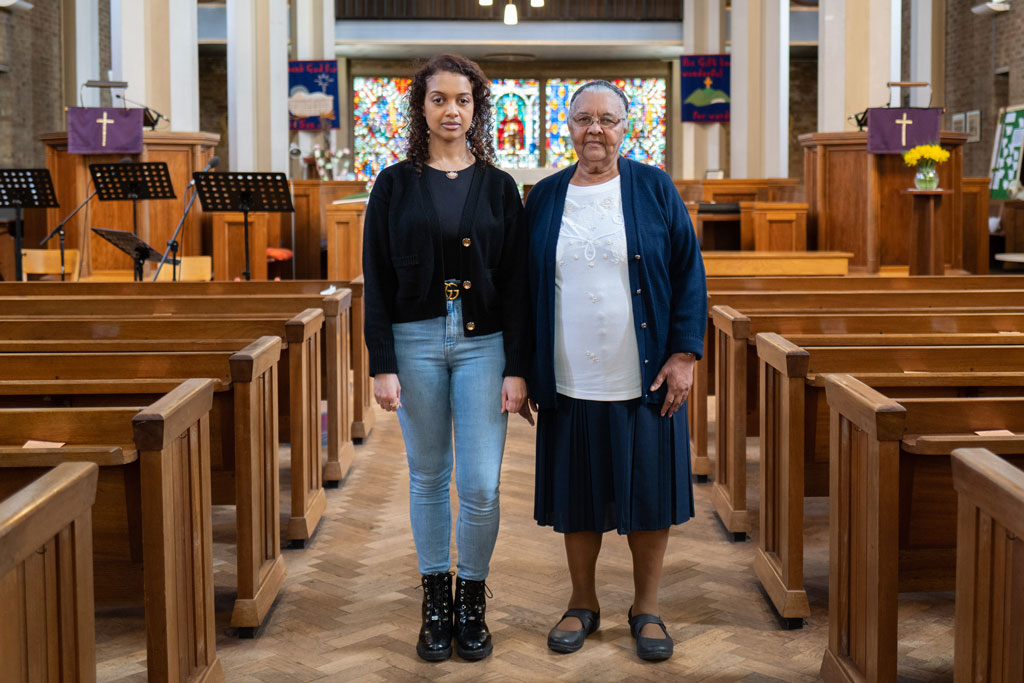
Julia Nimmons and Monica are members of the Racial Justice Group established by St James’ Church. Julia is one of the youngest members, Monica one of the oldest and is first generation – arriving from Jamaica in 1964 aged 21 Photo credit: Jim Grover.
‘This exhibition is partly about the ties that bind us – family and tradition – but it is also about change and the future as a younger generation decide who they are and what matters to them,’ writes curator Barron in the book. Grover’s images layer a bigger picture of ways in which heritage and legacy are conserved, through food, rituals and gatherings. They raise universal, cross-cultural questions about what we as individuals and families want to share, treasure and remember.
The exhibition opens with first-generation Alford Gardner and ends with one of Grover’s favourite photographs, a family portrait of 34-year-old school teacher Quincy Rowe, who is third generation of Jamaican heritage, and his partner Natasha Paine, with their baby son Jaxxon. ‘When we had our baby shower… it was all about our two families coming together. It was perfect because our families and friends got to know each other. It was celebratory. We had both types of food and everyone talked about that,’ says Natasha.
Windrush: A Voyage through the Generations is on at Clapham Library on Clapham High Street until 2 September. The accompanying book containing the complete set of stories and interview transcripts is available to buy in print for £25 (around $30), or £10 (around $12) as a downloadable PDF. To find out more visit www.windrushvoyagethroughthegenerations.com.
Related content:
- Complete guide to Portrait photography – How to get started
- Best cameras for photojournalism and documentary in 2023
- Best photography exhibitions to see in 2023
- Carolyn Mendelsohn: Portraits of women in the landscape
Follow AP on Facebook, Twitter, Instagram, YouTube and TikTok.


